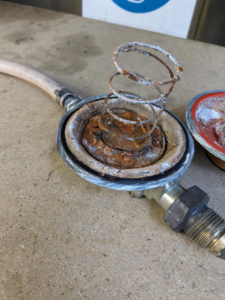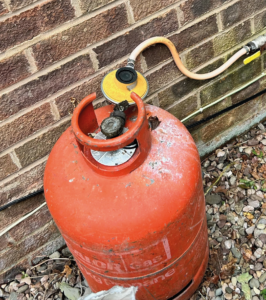The dangers of poorly maintained LPG regulators
This article appears in the March-April 2025 issue of Registered Gas Engineer.
LPG regulators in poor condition can lead to devastating consequences. Paul Salter, technical sales engineer at Clesse UK, sets out what you need to know, check and do.
As Gas Safe registered engineers, safety underpins everything we do. Every day, we might spot potential hazards and issue At Risk and/or Immediately Dangerous notices.
But there are hidden dangers that are not immediately apparent and can be missed. LPG cylinder regulators are often overlooked in regular maintenance schedules, with some considering it sufficient if the appliance pressure and lock-up are OK to continue without looking at the condition and age of the regulator. All too often I see LPG equipment that is old (often 20 years or more) and poorly maintained regulators and associated hosing.
For the past 10 years, over-pressure shut-off (OPSO) protection has been required, cited in British Standards and Liquid Gas UK Codes of Practice.
Regulators can pose a risk to both life and property, particularly when fitted without an OPSO, where failure to work correctly can lead to excessive pressure inside the property, which can lead to severe gas leakage. Yet many people are unaware of these dangers and often overlook equipment that is clearly old but that they think still “works fine”.
It’s our responsibility to educate customers about these risks. People may be reluctant to replace equipment that they think is functional: but explaining the consequences of neglecting aged and unsuitable equipment will almost certainly change their minds.
What can I do?
Make sure you are fully up to date with the current industry standards and guidance:
• IGEM/G/11 Edition 2, the Gas Industry Unsafe Situations Procedure: “Existing single-stage LPG regulators without OPSO protection, where the regulator is known or suspected to be 10 years old or greater, or where such a regulator exhibits evidence of significant environmental degradation are deemed At Risk.” – Clause 13.9.
• Liquid Gas UK Consumer Guidance Sheet 39: “When selecting a regulator, it is recommended that a model with a means of protecting the downstream hose, pipework and appliance from overpressure in the event of regulator malfunction is used.
“Such devices [include]: a regulator incorporating an Over Pressure Shut Off (OPSO) – a requirement for most installations in residential and habitable properties in the UK and commercial activities covered by the Gas Safety Installation and Use Regulations (GSIUR) and installation standard BS 6891.”
Never install second-hand equipment or buy it from non-reputable retailers or suppliers under any circumstances. Some websites are awash with 20+ year-equipment, advertised as “retro.”
Many property owners, landlords and holiday park operators are unaware of the advice on aged equipment and the risks they face. One of the best ways to bring home the importance of this issue is by sharing real-world incidents, such as that in December 2023, when an LPG explosion at a holiday lodge in Stafford caused serious burns to a woman. The lodge was completely destroyed by the explosion and the subsequent investigation found that a single-stage regulator supplying the lodge was 13 years old and did not have OPSO protection1.
Be alert for these red flags
• Significant corrosion or environmental degradation
• Non-OPSO regulators
• Single-stage regulators
• Rusty pigtail connections
• Perished rubber hosing
• Absence of visible manufacturing dates on regulators
• Upwards-facing vents and blocked vents.
Neglect
Although it is our responsibility to ensure the safety of every installation we service, we know that some customers neglect to schedule annual maintenance. This issue is particularly common when the gas supply is connected exclusively to a cooking appliance. I regularly see the types of installation shown in the pictures below.
The photos show most of the red flags: upon opening the regulator, it is evident that it was likely to fail, resulting in an Immediately Dangerous situation.
We know that replacing outdated equipment will cost users time and money but most regulators will last for up to 10 years. And the cost will fall well short of the damage incurred when failures do arise.
By educating our customers, making sure we follow the regulations and encouraging customers to have us carry out regular inspections, we can reduce the number of unsafe installations and safeguard lives and property across the UK.

